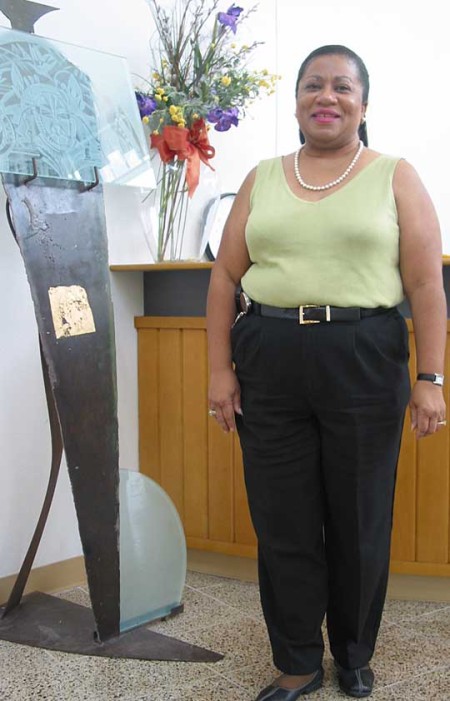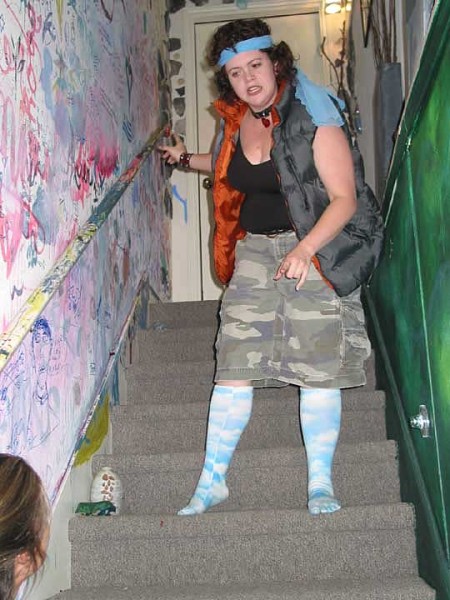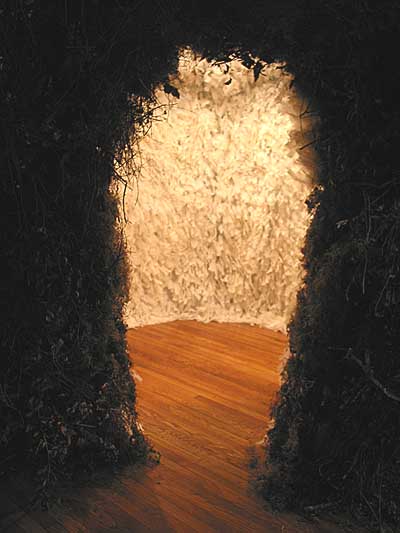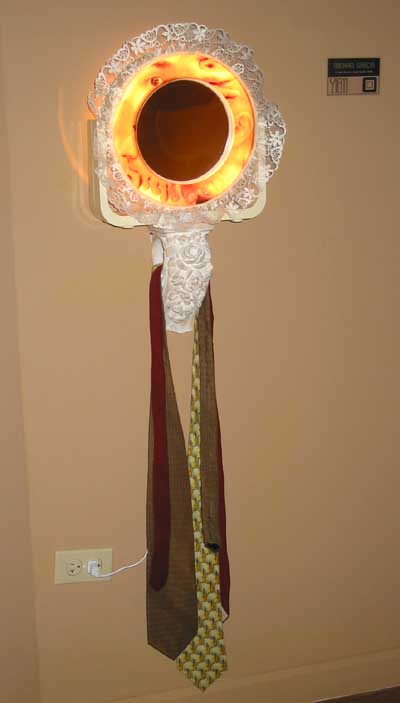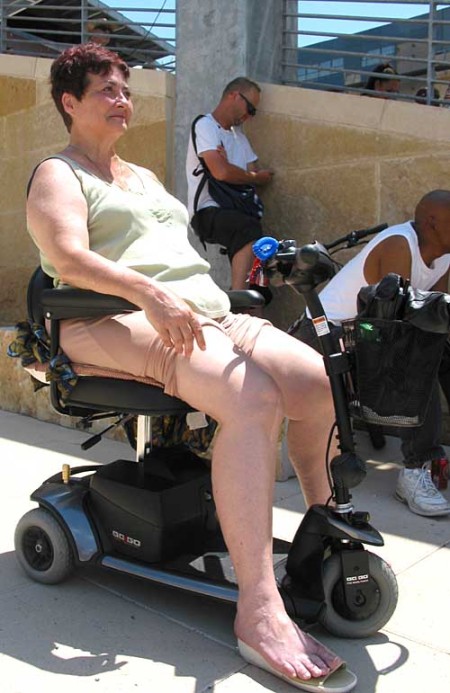lithebast moved to Blogger in 2008. See my new blog there.
lithebast blog moves to Blogger
February 13, 2008At The Carver Museum –Austin
December 7, 2006The George Washington Carver Museum and Cultural Center in Austin is located on the city’s near east side. It’s next to the Carver Branch Library, which once was the only public library open to Blacks in Austin.
The museum has a wonderful light filled atrium lobby. Please see the photos below. It’s like walking into a forest clearing. The museum encourages people to think about and to be proud of their family’s history, no matter who their family may be.
I saw a wonderful exhibit on Juneteenth, a celebration of the end of slavery in the U.S. I did not realize until I saw the exhibit that slaves in Texas were the last in the US to learn that they had been set free. They learned this two and half years after President Lincoln’s Emancipation Proclamation was official. That’s a long time to be forced to work for free.
The Emancipation Proclamation was first read in Texas at Galveston in 1865. As far as I know, no plaque has been placed in Galveston to commemorate this historical event, but one has been planned.
Also in the museum are photographs and historical accounts of Austin African-American families. I found the map displaying locations of early African American communities in Austin to be very interesting. I knew about a couple of early communities on the West side of town, but I did not realize that there were others around town.
Bernadette M. Phifer (above) is the Carver Museum’s Curator. When I inquired about Austin’s original Emancipation Park, she told me that it was now a housing development located across from Rosewood Park, where Austin’s official Juneteenth is now celebrated.

Jewel Boswell Hudson, is a docent at the Carver Museum. Her radiant smile welcomes visitors to the museum.
Both women are impeccably and professionally groomed. They are a credit to Austin and to the George Washington Carver Musuem.
At The LBJ Museum –Austin
October 9, 2006The LBJ Museum has an exhibit called, Power To The People. It opened in September on Free Museum Day and will continue until May 28. Power To The People is about rural electrification in Texas and of President Johnson’s efforts to bring electrical power lines to rural Texas through the Rural Electrification Administration (REA) in the 1930s.
Ironically, although people in rural areas did not have electricity before the REA, many did have telephones, that they used not only for communication but also for entertainment. Some listened to concerts over the telephone and some listened to their neighbors’ conversations, because they had telephone party lines, the forerunners of today’s reality shows and computer forums. However, the electrical power lines disrupted these early magneto telephones.
After the REA finished installing the power lines, it then started another program for installing telephones that were compatible with electric power lines, and it also began to install private telephone lines which led to the demise of the party line.
Still, this is an interesting exhibit even if it doesn’t tell the whole story. The exhibit recounts how some women burned off their fingers accidentally while heating heavy irons on wood-burning stoves for ironing clothing before electricity and electric irons were available. However, the exhibit omits the fact that early electrical irons with their exposed wires were often as dangerous if not more so than earlier irons. Talk about extreme ironing!
My grand aunt lost her fingers to an early electric iron. She was struck by lightening while ironing during a thunder storm. Her fingers were left stubs. Her fiancé , an up-and-coming minister, called off their engagement after the accident, and she returned home to keep house for her bachelor farmer brothers. Despite having stubs for fingers, she could perform most household chores.
As I wandered through the exhibit, I heard an older woman’s voice narrating in the movie viewing rooms. I wondered who it was, and it was not until I looked more closely at my program that I realized that it was Mrs Johnson herself narrating. Mrs. Johnson now in her 90s is blind due to macular degeneration. I did not see Mrs. Johnson on my visit, but I did see a wonderful large inter-generational photograph mural of her family which included her children and grandchildren.
Speaking of families, it was only fitting that the Johnny Gimble band, a family western swing band which includes three generations of musicians–Johnny, Dick, and Emily played and sang at at the LBJ museum open house.
Johnny Gimble cuts a dashing figure in his western attire, boots, and inlaid belt
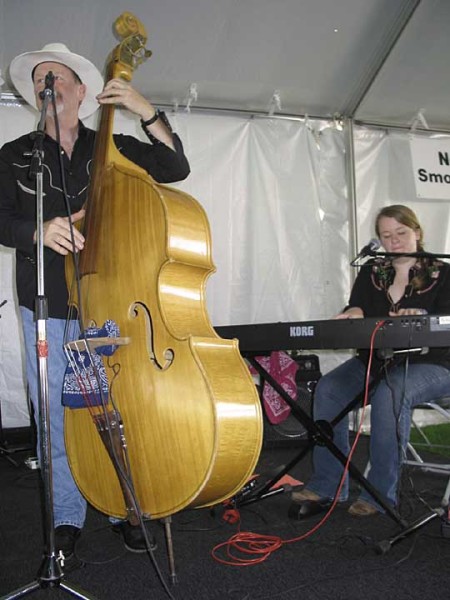
His son, Dick, and granddaughter, Emily, dressed in black western shirts joined him on stage. They played to the BBQ eating crowd gathered in the tents in front of the LBJ museum.
Ann Richards –Texas Ethics
October 1, 2006I can still see Ann Richards and Barbara Jordan sitting at a conference table with the Texas Senate Subcommittee on Ethics. It was 1991. Ann Richards was governor and Barbara Jordan was her ethics adviser. They were gently trying to convince the senators that they needed to pass a bill to give more public scrutiny over gifts or cash contributions that they received while holding office or running for office.
It was a low-key meeting. Sunshine streamed into the richly wood adorned senate chambers where handsomely painted portraits of past Texas state senators stared at one another.
Most of the senators sitting around the conference table were wearing dark gray suits. Governor Richards and Ms. Jordan were wearing dark somber clothing appropriate for the occasion.
No one asked, “Do these gifts and special favors make me look ugly?”
Instead, a senator shifted in his leather chair uncomfortably. He said that he did not want his neighbors in his home district to know how what or how much he was receiving in gifts– it would embarrass his wife and family, he claimed. His constituents would not understand why these gifts and financial contributions were necessary.
Governor Richards backed by Ms. Jordan said that the public had a right to know what gifts and cash contributions that the legislators were receiving and from whom, because it had elected them. The public’s faith in them as elected officials would be damaged if they did not agree to have more public scrutiny over the gifts that they received. This was the price they paid for holding public office, Richards said.
Later that session, an ethics law was passed, and the Texas Ethics Commission was created to give more public oversight over gifts and cash donations that elected officials and public employees received. It replaced the State Ethics Advisory Commission.
One immediate effect was that all of us who worked for the legislature in the next session had to attend an ethics training presentation. I wondered why I had to attend the training. I couldn’t imagine anyone offering me, a low-level legislative employee, a gift or cash to influence legislation. As I watched the presentation, I wondered if the legislators themselves also had to attend the same class. I thought that perhaps they might excuse themselves, given the fact that they had passed the ethics law.
I did see some impact from the ethics law. In the first session under Governor Richards, parties and gift baskets from lobbyists flowed freely as “good will gestures” to the legislature and their staffs. But after the passage of ethics legislation there were fewer parties. Also, I saw fewer gift baskets being delivered on the last day of the session in contrast to Governor Richard’s first session.
Other than this, the Texas Ethics Commission and ethics laws appear to have had little effect on Texas legislators. If the commission really had been concerned with ethics, it would have gone after Tom Delay, the former Texas State Representative, immediately after allegations surfaced that he had violated state campaign laws instead of waiting for the federal House Ethics Committee to formally sanction him. Are national politicians from Texas exempt from Texas state ethics laws?
Just a week after Ann Richards’ death, The Texas Ethics Commission announced that legislators did not have to specify the amounts of gifts or cash donations that they received. They could just call it cash. A few days later, after a large uproar, the Commission decided that perhaps it should reconsider its decision.
Perhaps the Texas Ethics Commission needs to find that ethics training presentation and watch it for itself before it issues any more opinions.
Muses –Austin
September 11, 2006I like unconventional plays, and Muses: Memories of A House by the Vestige Group is unconventional. According to Carl Jung, a house is a reflection of one’s self and rooms represent personality aspects. This particular house belongs to a woman who is a storyteller and artist. This shows in the artwork, family treasures, and mementos throughout the house.
In this play or rather vignettes written specifically for each space, the audience travels in small groups between spaces in and around the house and observes different personalities and experiences.
This is an actress performing in Muses. She looks rebellious and urban hip hop in her flak vest, camo skirt, and blue headband. This is definitely youth fashion.
Muses has a short run. It has only one more weekend to go, September 15-17. Tickets are available only through advance sales such as www.tix.com. Check Vestige’s website for more details.
Disclaimer: I have no affiliation with the Vestige Group, nor do I know them personally, but I do like the way they play with ideas and themes.
Real Women Lunch– Austin
September 1, 2006If you can understand the instruction manual that came with your software, computer, microprocessor, or microchip production equipment, thank a technical writer.
These technical writers are having lunch at the former Austin location of MTV’s Real World TV series house. They work for some of the most prestigious high tech corporations in the US. These wordsmiths help create Silicon Hills’ (Austin’s) culture and economy. Some are card-carrying members of the Society of Technical Communication (STC).
I like the way that they are dressed. The red Hawaiian shirt flatters the dark hair and complexion of the woman on the far right, while lighter colors enhance the lighter skin tones and hair of the other women. These are real women who dress well and work for a living.
At Youth Voices’ Book Signing–Austin
August 21, 2006On Saturday, August 19, I attended a book signing by young authors,Youth Voices in Ink, sponsored by Badgerdog. I was impressed by these young people and their work.
Here, some of the writers pause for refreshments while signing. Three are wearing Badgerdog T-shirts, and they look very comfortable in them. T-shirts have long been a fashion staple, especially when they have clever slogans or designs on them. The girl on the right is wearing some great eyeglasses with rhinestones.
This is part of a poem by one of the young writers,
Upperclassman Bold
by Alix Scarborough
Her lips are like mine
–glossy–
They glint and sparkle
in the morning sun.
Only mine are pale-pink
freshman lips
Hers–a vivacious upperclassman
RED
Her hands perch
casually
on the bus seat in front of her.
Purple nails manicured,
tap a rhythm:
rat-a-tat-tat
rat-a-tat-tat
rat-a-tat-tat
I stare at the sunglasses,
twined in her
(obviously dyed)
black hair.
as if “Prada” was some
portal to her soul.
She feels my eyes
and she glances.
The way she looks at me
doesn’t make me shy away….
This is Michael Espinoza, who participated in the Texas School for the Blind and Visually Impaired summer writing workshop. I asked him if red was his favorite color. He said, “No, I like black, but my mother made me wear red.” He’s wearing a great smile and a really cool haircut–very appropriate for the 100 degree weather we’ve been having lately. This is one of Michael’s poems–
The Chains That Bind
by Michael Espinoza
These chains that bind me now,
are not the ones I know,
nor the ones I love.
Bound by pain and loss,
tormented with fleeting visions of love.
These are the chains that bind.
Why can they not be the chains I know
the ones I trust with all my heart.
Why must they be the chains I fear,
and not the ones you hold in your hand.
The cold metal bites my skin with fury,
no longer the gentle cold caress,
but the pain of emptiness and sorrow,
that burns like acid in my blood.
These are not the chains I love,
these are the chains that bind.
Jessica Espinoza, Michael’s sister, accompanied her family to the book signing. According to her father, Jessica also is an excellent writer as well as an excellent musician. Jessica looks fashionable and comfortable in a tropical print sleeveless dress.
Blind people are very skilled at coordinating their clothing. According to Jessica, braille tags help them to distinguish between colors and even patterns. There is even clothing with braille words. Cafe Press has T-shirts in braille as does brailletshirts. One popular slogan in braille, is, “If you can read this, you’re too close.”
At Mexic-Arte Museum –Austin
August 9, 2006On August 3, I attended Mexic-Arte Museum‘s opening for an exhibition of up and coming Latino artists in Texas under the age of 35, Juventud Desenfrenada or Youth Gone Wild.
Mexic-Arte Museum was founded in 1984. It is small and located in an old building on Congress Avenue. The evening was hot and steamy, like many other recent evenings, here in Austin. Unfortunately, Mexic-Arte has no air conditioning. Hopefully that will change if Austinites approve Proposition 4 this November, which would enable Mexic-Arte to renovate its quarters.

There were many fashionably dressed people at the art opening. Grace Zuniga dressed in a red dress is an artist exhibiting at the museum. Ms. Zuniga’s medium is photography and her work has a spiritual quality to it. She is posing for a photo being taken by the woman in a black dress on the left. They’re both wearing great dresses and accessories for the event and season.
Ms.Zungia is posing in front of the Quinceañera installation by Angel Quesada. The woman sitting in a chair behind the photographer is the mother of Mexic-Arte’s director, Sylvia Orozco.
Artist, Kimberly Garza Campell, also showing her work at the museum, stands with her family, while waiting to be announced. She’s wearing a wonderful red necklace. Her husband looks very comfortable in his pressed white shirt and gray slacks despite the heat. Ms Garza Campell works in scupture and painting. Her art is complex and sophisticated.
This is the opening to a human size nest, Nido, by Cesar Alexander Villareal. The inside is lined with feathers and has a camera watching over those inside the nest. It suggests vigilance, comfort and home security.
The preoccupation with personal appearance is evident in this work, In High Esteem, by Michael Garcia.
The exhibit ends October 1. It’s worthwhile to go.
At Ter’ell Shahid Concert –Austin City Hall Plaza
July 19, 2006On Fridays at noon, the Austin City Hall Plaza holds free concerts. The Austin City Hall is new. The plaza faces Town Lake and Cezar Chavez Street.I attended the Ter’ell Shahid Concert on July 14. Mr. Shahid classifies himself as neosoul. He has an excellent sound.African Americans reportedly make up about 10% of the population of Travis County, which includes Austin.Last year, the City of Austin released an African American Quality of Life Scorecard. I like the knit hat and necklace that Mr. Shahid is wearing. The woman vocalist has a great haircut, and I love the paisley print blouse. Denim in skirts and pants are really in style in Austin. I like the knit hat and necklace that Mr. Shahid is wearing. The woman vocalist has a great haircut, and I love the paisley print blouse. Denim in skirts and pants are really in style in Austin.
These three ladies enjoying the Shahid concert have great style.The woman on the right has wonderful braided hair. I wish that I could have gotten a closeup photo of the back of her head. Like the female vocalist, she too is wearing a denim skirt and V-neck blouse.
Also at the concert was this woman on her scooter. I like her well coifed auburn hair and her color–the pale green shell with pale peach shorts. |
